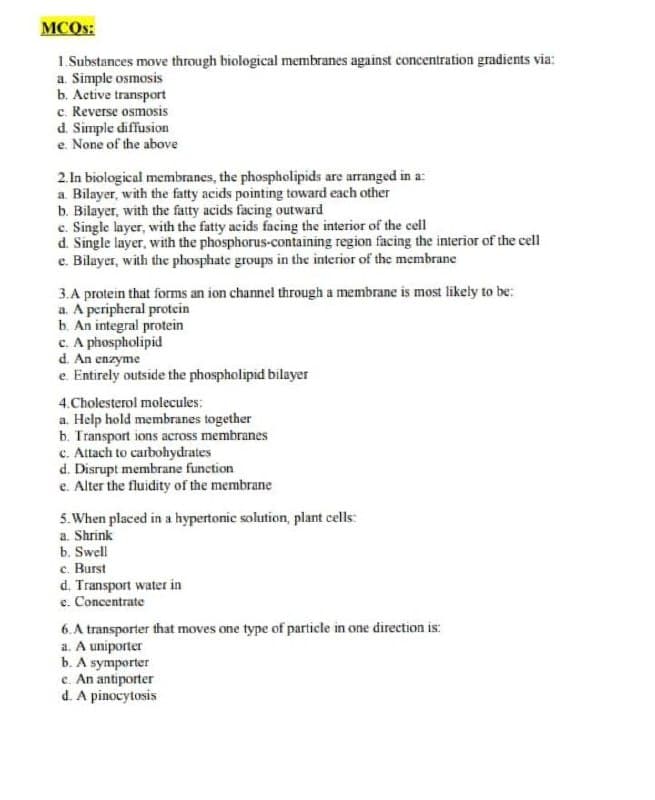1. Substances move through biological membranes against concentration gradients via: a. Simple osmosis b. Active transport c. Reverse osmosis d. Simple diffusion e. None of the above 2. In biological membranes, the phospholipids are arranged in a: a Bilayer, with the fatty acids pointing toward each other b. Bilayer, with the fatty acids facing outward c. Single layer, with the fatty acids facing the interior of the cell d. Single layer, with the phosphorus-containing region facing the interior of the cell e. Bilayer, with the phosphate groups in the interior of the membrane 3.A protein that forms an ion channel through a membrane is most likely to be: a. A peripheral protein b. An integral protein c. A phospholipid d. An enzyme e. Entirely outside the phospholipid bilayer
1. Substances move through biological membranes against concentration gradients via: a. Simple osmosis b. Active transport c. Reverse osmosis d. Simple diffusion e. None of the above 2. In biological membranes, the phospholipids are arranged in a: a Bilayer, with the fatty acids pointing toward each other b. Bilayer, with the fatty acids facing outward c. Single layer, with the fatty acids facing the interior of the cell d. Single layer, with the phosphorus-containing region facing the interior of the cell e. Bilayer, with the phosphate groups in the interior of the membrane 3.A protein that forms an ion channel through a membrane is most likely to be: a. A peripheral protein b. An integral protein c. A phospholipid d. An enzyme e. Entirely outside the phospholipid bilayer
Biology: The Dynamic Science (MindTap Course List)
4th Edition
ISBN:9781305389892
Author:Peter J. Russell, Paul E. Hertz, Beverly McMillan
Publisher:Peter J. Russell, Paul E. Hertz, Beverly McMillan
Chapter5: Membranes And Transport
Section: Chapter Questions
Problem 4TYK: A characteristic of carrier molecules in a primary active transport pump is that: a. they cannot...
Related questions
Question

Transcribed Image Text:MCOS:
1. Substances move through biological membranes against concentration gradients via:
a. Simple osmosis
b. Active transport
c. Reverse osmosis
d. Simple diffusion
e. None of the above
2.In biological membranes, the phospholipids are arranged in a:
a. Bilayer, with the fatty acids pointing toward each other
b. Bilayer, with the fatty acids facing outward
c. Single layer, with the fatty acids facing the interior of the cell
d. Single layer, with the phosphorus-containing region facing the interior of the cell
e. Bilayer, with the phosphate groups in the interior of the membrane
3.A protein that forms an ion channel through a membrane is most likely to be:
a. A peripheral protein
b. An integral protein
c. A phospholipid
d. An enzyme
e. Entirely outside the phospholipid bilayer
4.Cholesterol molecules:
a. Help hold membranes together
b. Transport ions across membranes
c. Attach to carbohydrates
d. Disrupt membrane function
e. Alter the fluidity of the membrane
5. When placed in a hypertonic solution, plant cells:
a. Shrink
b. Swell
c. Burst
d. Transport water in
e. Concentrate
6. A transporter that moves one type of particle in one direction is:
a. A uniporter
b. A symporter
c. An antiporter
d. A pinocytosis
Expert Solution
This question has been solved!
Explore an expertly crafted, step-by-step solution for a thorough understanding of key concepts.
This is a popular solution!
Trending now
This is a popular solution!
Step by step
Solved in 2 steps

Knowledge Booster
Learn more about
Need a deep-dive on the concept behind this application? Look no further. Learn more about this topic, biology and related others by exploring similar questions and additional content below.Recommended textbooks for you

Biology: The Dynamic Science (MindTap Course List)
Biology
ISBN:
9781305389892
Author:
Peter J. Russell, Paul E. Hertz, Beverly McMillan
Publisher:
Cengage Learning

Human Physiology: From Cells to Systems (MindTap …
Biology
ISBN:
9781285866932
Author:
Lauralee Sherwood
Publisher:
Cengage Learning

Concepts of Biology
Biology
ISBN:
9781938168116
Author:
Samantha Fowler, Rebecca Roush, James Wise
Publisher:
OpenStax College

Biology: The Dynamic Science (MindTap Course List)
Biology
ISBN:
9781305389892
Author:
Peter J. Russell, Paul E. Hertz, Beverly McMillan
Publisher:
Cengage Learning

Human Physiology: From Cells to Systems (MindTap …
Biology
ISBN:
9781285866932
Author:
Lauralee Sherwood
Publisher:
Cengage Learning

Concepts of Biology
Biology
ISBN:
9781938168116
Author:
Samantha Fowler, Rebecca Roush, James Wise
Publisher:
OpenStax College

Anatomy & Physiology
Biology
ISBN:
9781938168130
Author:
Kelly A. Young, James A. Wise, Peter DeSaix, Dean H. Kruse, Brandon Poe, Eddie Johnson, Jody E. Johnson, Oksana Korol, J. Gordon Betts, Mark Womble
Publisher:
OpenStax College

Biology: The Unity and Diversity of Life (MindTap…
Biology
ISBN:
9781305073951
Author:
Cecie Starr, Ralph Taggart, Christine Evers, Lisa Starr
Publisher:
Cengage Learning